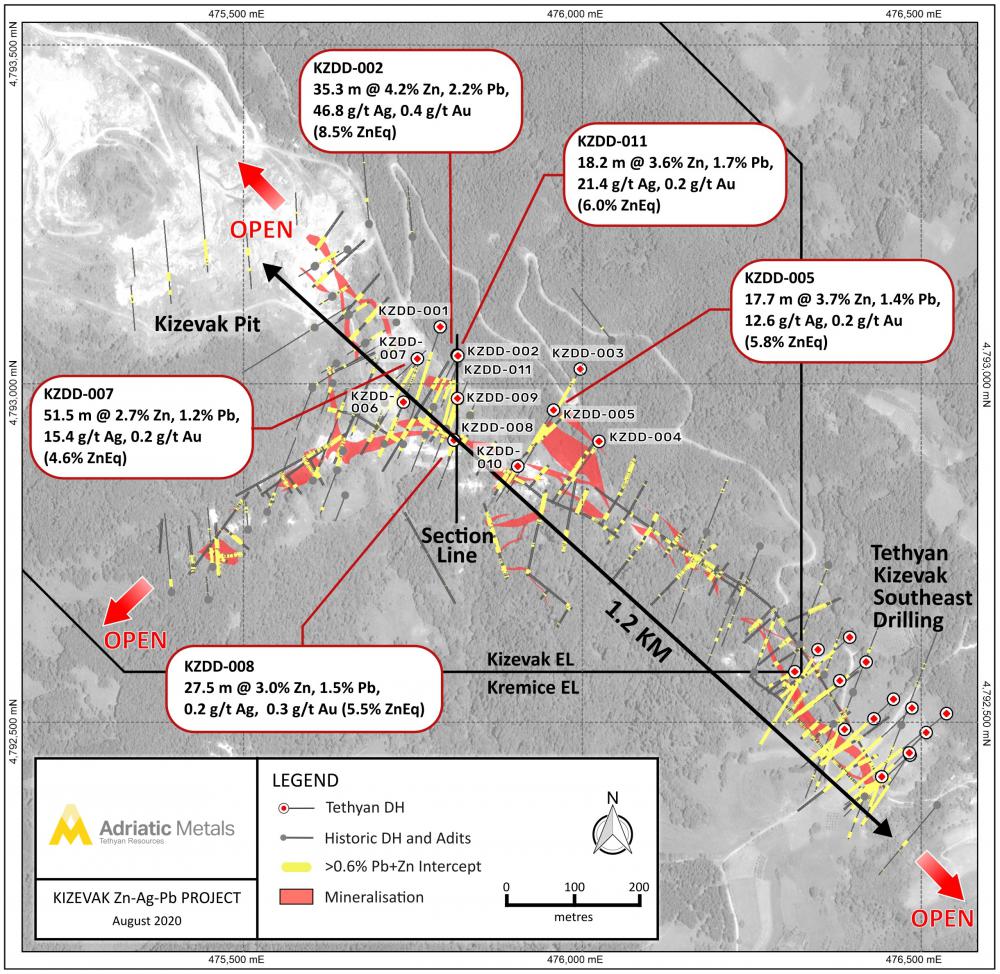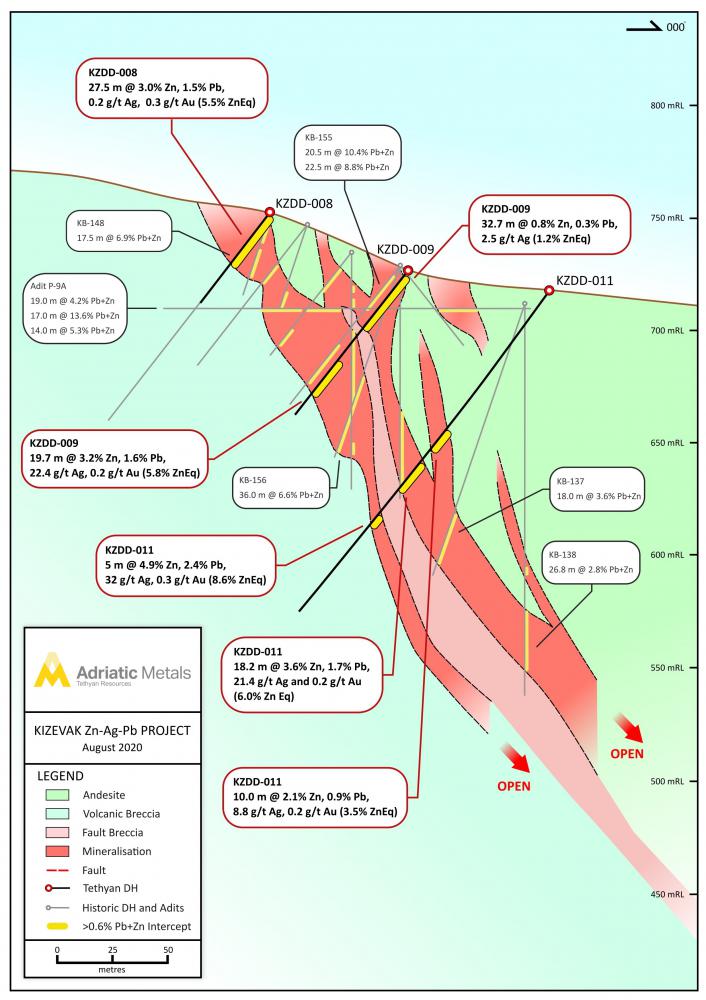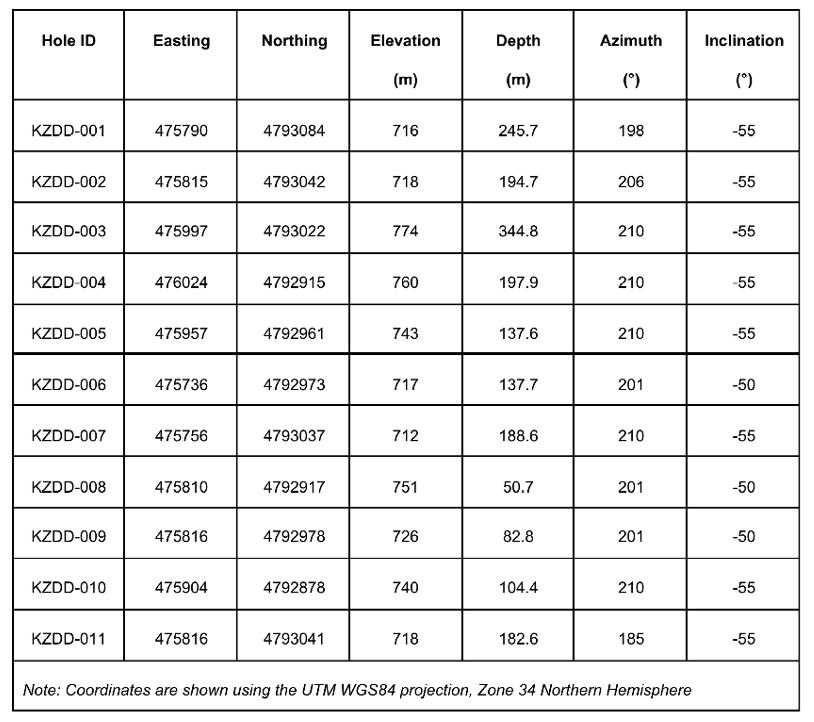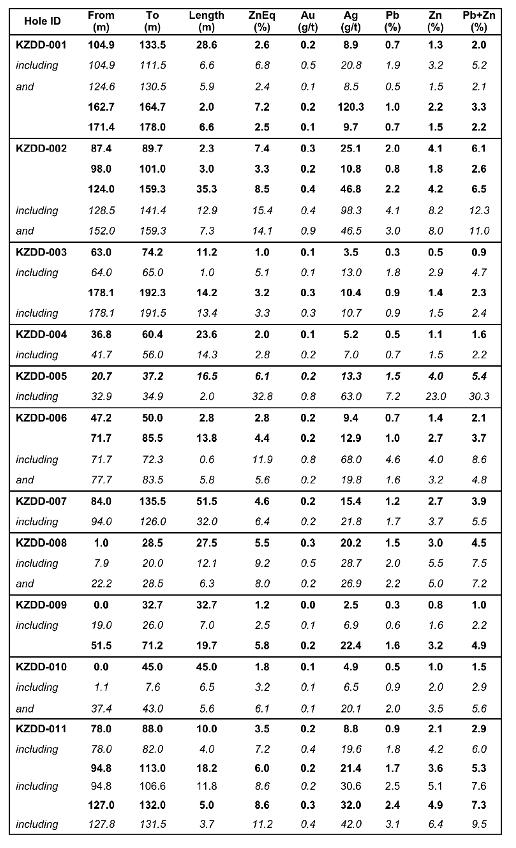Recent Kizevak Drilling Highlights (Summer 2020)
Serbian Project News
2 September 2020
Drilling extended mineralisation outside of the historic data, including the discovery of a blind, high-grade mineralised structure in hole KZDD-002, which returned 12.9m at 8.2% Zn, 98.3g/t Ag, 4.1% Pb and 0.4g/t Au (15.4% ZnEq) within a broader interval of 35.3m at 4.2% Zn, 46.7g/t Ag, 2.2% Pb and 0.4g/t Au (8.5% ZnEq) from 124.8m
- Confirms the presence and tenor of mineralisation as shown in historic records, indicating good continuity of Zn-Ag-Pb mineralisation from surface to depths in excess of 200m (Figure 2).
- Identified broad mineralised halos to high grade structures that were not recognised in historic data due to selective sampling, better suited to an open pit target.
- Significant Ag grades and indications of increasing Au grades at depth to be vectored towards in future drilling.
- Mineralisation remains open in all directions.
Significant intercepts are shown in Table 1 and further details of the drill programme include:
Continuity and Depth Extensions to Mineralisation
Drilling confirmed that mineralisation occurs from surface and extends relatively continuously to in excess of 150m depth, where it remains open for expansion. For example, as shown in Figure 2, drill holes KZDD-008, KZDD-009 and KZDD-011 intersected a broad and continuous mineralised structure from surface to approximately 150m depth that remains open.
- 27.5m at 3.0% Zn, 20.2g/t Ag, 1.5% Pb and 0.3g/t Au for 5.5% ZnEq (KZDD-008, from 1m)
- including 1m at 5.5% Zn, 28.7g/t Ag, 2.0% Pb and 0.5g/t Au for 9.2% ZnEq
- 19.7m at 3.2% Zn, 22.4g/t Ag, 1.6% Pb and 0.2g/t Au for 5.8% ZnEq (KZDD-009, from 51.5m)
- 18.2m at 3.6% Zn, 21.4g/t Ag, 1.7% Pb and 0.2g/t Au for 6.0% ZnEq (KZDD-011, from 94.8m)
Additionally, drilling beneath shallow historic underground exploration adits, where there is no historic drill data, has the potential to significantly extend known mineralisation to depth. For example, KZDD-003 intercepted a 14m wide interval of mineralisation 80m down dip of a historic adit intercept and remains open. This is in a 300m long zone where there are only shallow exploratory adits and no historic drilling, representing a key area for future exploration.
Broad Mineralised Widths
Tethyan drilled four twin holes (KZDD-002, KZDD-006, KZDD-008 and KZDD-009), which show good alignment with the position of historic mineralised intervals. However, typically the Tethyan holes have intercepted broader intervals than reported historically, which is interpreted to be a result of selective sampling of historic holes, causing a bias to narrower intervals of higher grades in the historic data. This therefore presents an opportunity to explore for a larger scale project than indicated by historic exploration data.
- 51.5m at 2.7% Zn, 15.4g/t Ag, 1.2% Pb and 0.2g/t Au for 4.2% ZnEq (KZDD-007, from 84.0m)
including 32m at 3.7% Zn, 21.8g/t Ag, 1.7% Pb and 0.2 g/t Au for 4% ZnEq
Discovery of New Mineralised Zones
Exploration drilling has discovered a blind, sub-parallel structure in holes KZDD-002 and KZDD-011. This structure is wide and contains high grade Zn, Ag, and Pb with anomalous Au. There is potential for the discovery of additional sub-parallel mineralised zones with continued exploration.
- 35.3m at 4.2% Zn, 46.7g/t Ag, 2.2% Pb and 0.4g/t Au for 8.5% ZnEq (KZDD-002, from 124.8m)
including 9m at 8.2% Zn, 98.3g/t Ag, 4.1% Pb and 0.4g/t Au for 15.4% ZnEq - 5.0 m at 4.9% Zn, 32g/t Ag, 2.4% Pb and 0.3g/t Au for 8.6% ZnEq (KZDD-011, from 127.0m)
Significant Ag Grades
Historic drill core was generally only assayed for Pb and Zn, whereas the Tethyan drill programme has shown the presence of significant Ag and anomalous Au grades. For example, drill hole KZDD-002 includes an interval of 5m at 211g/t Ag, 14.9% Zn, 7.8% Pb and 0.6g/t Au (from 136.4m), and has a separate Au-elevated interval from 150m of 8.8m at 0.96g/t Au, 40.3g/t Ag, 4.3% Zn and 2.6% Pb. Adriatic’s geologists have recognised that there may be potential for increasing Au grades to depth, a mineral zonation that is characteristic of epithermal vein-type deposits that represents a compelling target for future drilling.
Recommencement of Drilling
Adriatic plans to immediately follow-up on these positive drill results with continued verification and exploration drilling, geophysical surveys, soil sampling, and metallurgical test work at Kizevak.
Figure 1: Plan view map of the Kizevak project showing historic and Tethyan exploration drilling and adits, including highlight results from recent drilling. The inactive Kizevak open pit is visible to the northwest, and mineralisation extending to the southeast and southwest is entirely open for expansion through further drilling.

Figure 1: Plan view map of the Kizevak project

Figure 2: Cross-section through the Kizevak deposit showing a broad and continuous mineralised body extending from surface to 200 metres depth, which is open for expansion.

Table 1: Summary of drill assay results.
Notes
- Zinc Equivalent (Zn Eq.) metal grade was calculated using assumed metal prices of $1850/oz Au; $22/oz Ag; $1900/t Pb and $2350/t Zn.
- Metal recoveries of 100% were applied in the metal equivalent calculations.
- Zinc equivalent (%) was calculated using the following formula: ZnEq. (%) = 100 x ((Au price (g) x Au grade) + (Ag Price (g) x Ag grade) + (Pb price x Pb grade/100) + (Zn price x Zn grade/100))/Zn price.
- Intervals were calculated using a 0.6 % Pb+Zn cut-off with a maximum of 5 m consecutive internal dilution.
- Numbers may not add up due to rounding
- The true thickness of mineralised zones is estimated to vary between 70 to 95% of apparent width. Due to currently limited drilling data, early stage of exploration, variable geometry of the mineralisation and lack of outcrop, the Company is currently unable to accurately estimate true widths

Table 2: Drill Collar Data

